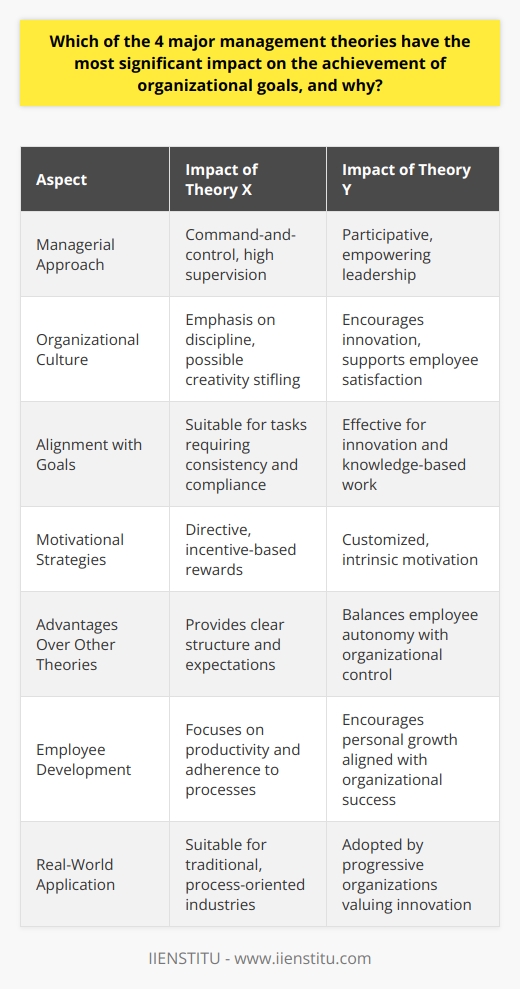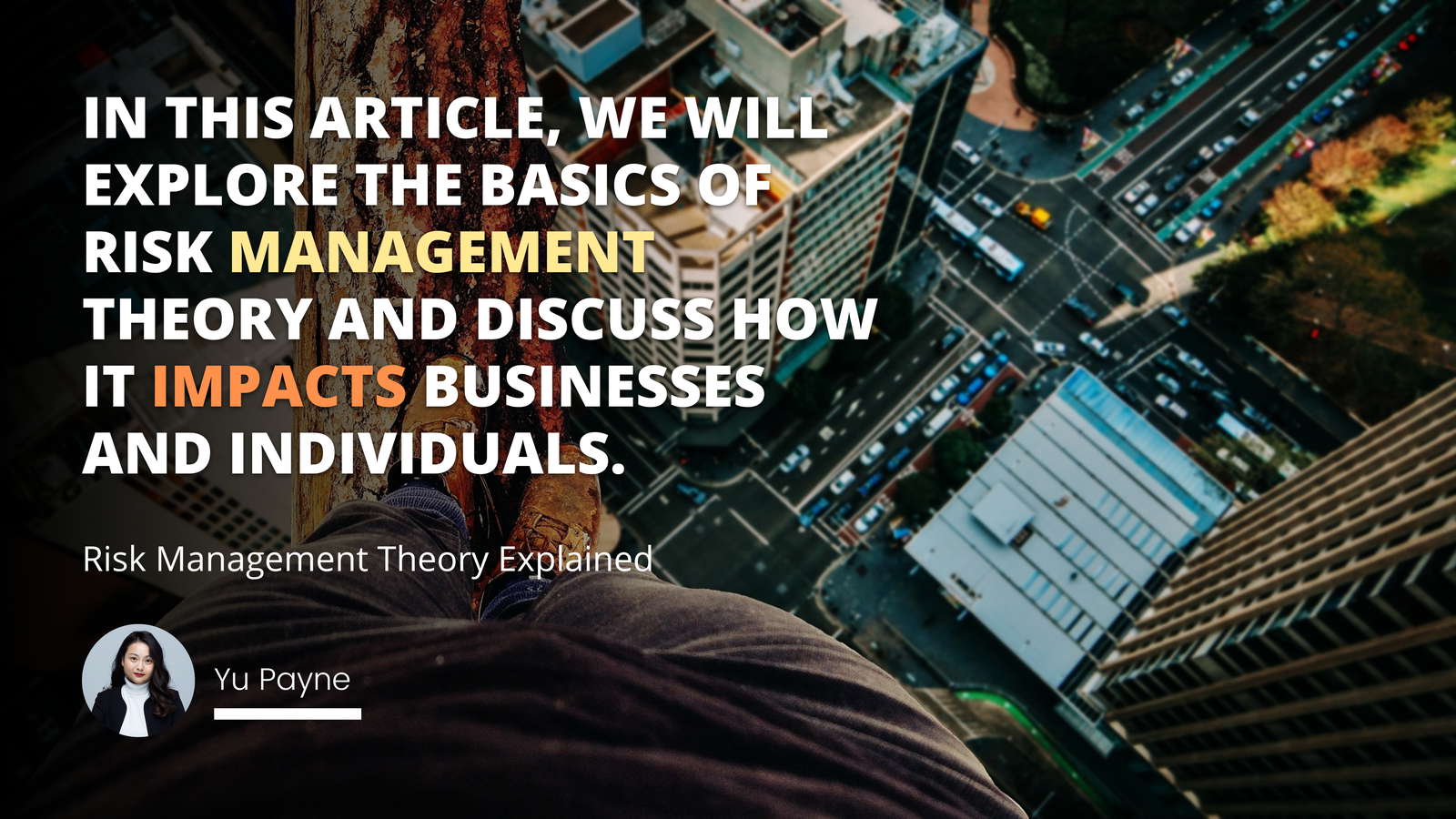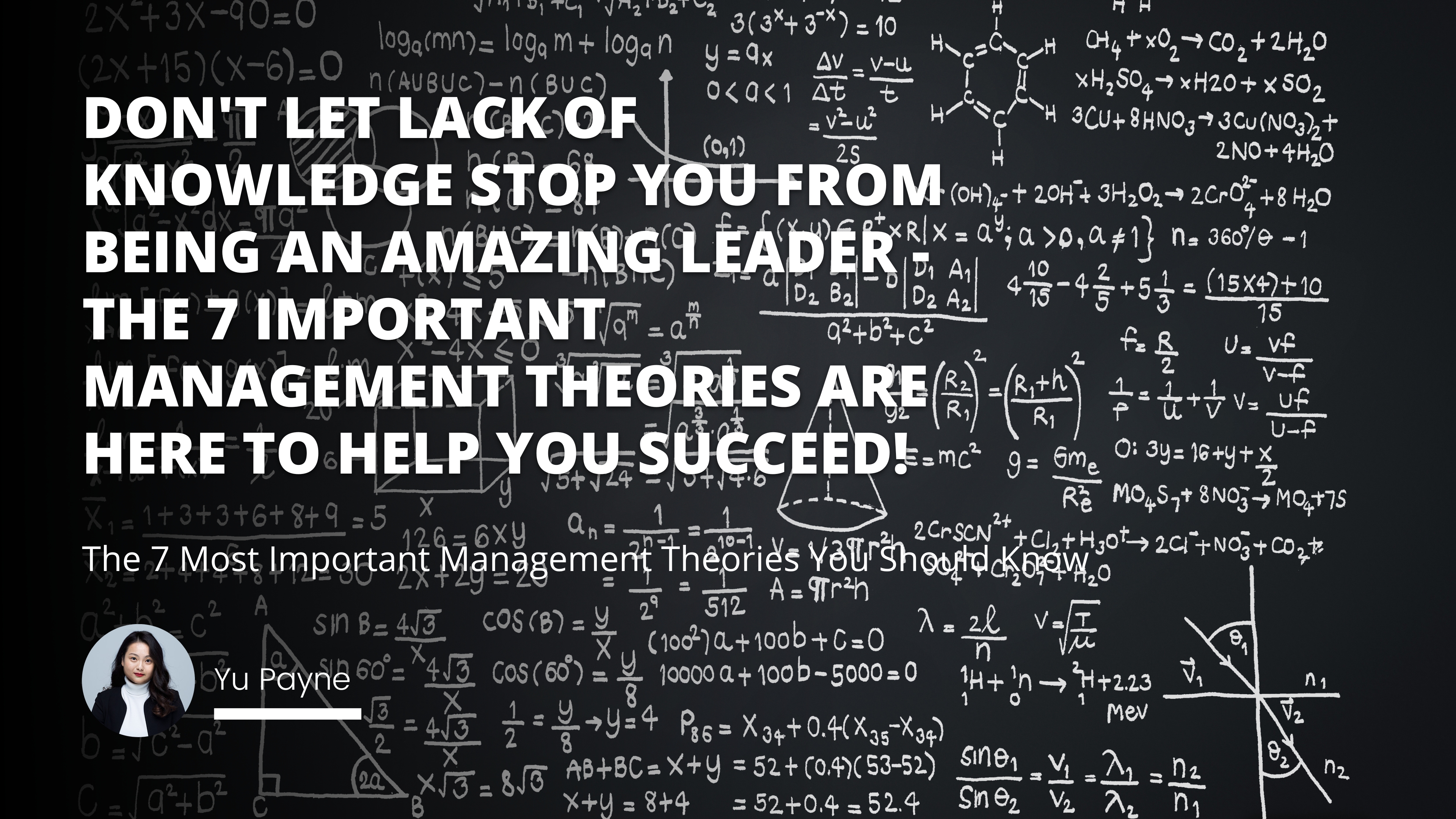
To be an effective manager, you must have a strong understanding of management theory. There are countless theories out there, but some are more important than others. This blog post will discuss the 7 most important management theories you should know. These theories will help you better manage your team and achieve success in your career.
The scientific management theory
In the early 20th century, a theory known as scientific management began to emerge in industrial workplaces. This theory, pioneered by Frederick Taylor, aimed to improve worker productivity by focusing on efficiency and accuracy throughout the workplace. At its core, scientific management is based on a division of labor; it seeks to break down complex tasks into more specific and specialized roles so that they can be carried out more quickly and with greater precision.
Taylor proposed an intensive data collection and analysis system to support this effort to identify areas that could benefit from a better organization or improved processes. The goal of focusing resources on these areas was to increase overall output while streamlining the work process. This approach has been adopted in many industries, such as manufacturing or customer service, where efficiency is critical.
Although its principles have since been revised over time to account for developments in technology and psychology, it remains an essential foundation in modern management theory.
The human relations movement
Since the dawn of human civilization, there has been a growing emphasis on bettering the relationships between people. This effort, known as the human relations movement, is based on the idea that developing better relationships between individuals and organizations can increase productivity and improve job satisfaction.
Over time, this approach has evolved substantially. The movement's early stages focused on improving communication between management and labor staff. Today, however, it also takes into consideration how technology can be used to streamline processes and how diverse teams can benefit from different perspectives.
In addition, the human relations movement encourages organizations to employ psychological approaches to employee-employer relationships that focus on understanding each other's needs. By fostering trust between organizational leaders and employees, an organization can create a culture of collaboration which in turn helps increase productivity. Moreover, team members learn to work together more effectively and efficiently through new developments, such as game-based training methods that reduce anxiety by placing everyone on equal footing during meetings.
Through continued progress in areas such as trust building, open communication, respect for diversity of thought, and leveraging technological advances—all championed by the human relations movement—organizations can continue down the path toward success while simultaneously having happier workers.
The Hawthorne effect
The Hawthorne effect refers to behavior changes resulting from the effects of observation. It is named after the famous Hawthorne studies conducted in the early twentieth century by researchers at Western Electric's Hawthorne plant. The main finding of these experiments was that when people were under constant observation, their output dramatically increased regardless of changes made to their working conditions or environment.
Such findings have subsequently been linked to numerous other research results and business-related decisions. For instance, they can help explain why customer service feedback is essential for businesses and why employees tend to work harder when they suspect they are being monitored. They can also help explain the phenomenon known as a "halo effect," wherein one good impression carries over into all future appearances.
Ultimately, understanding the Hawthorne effect can be especially beneficial for business owners and managers, who must consider its implications when forming policy or evaluating staff performance. In any case, it serves as an important reminder that our behavior often increases or decreases depending on how closely we feel we are being watched.
Theory X and Theory Y
Theory X and Theory Y are two theories of motivation that Douglas McGregor first proposed in 1960. While both approaches assume that employees dislike work and need to be coerced or controlled by managers, they differ in their perceptions of the best methods to achieve this.
Theory X assumes that employees are lazy and passionless and should be forced with rewards and punishments to perform tasks efficiently. On the other hand, Theory Y posits that if an employee is engaged in their job, then they will put in more effort; it emphasizes individual motivation over external coercion. Thus, theory X or theory Y can motivate them to succeed depending on how employers view their workforce. It is up to employers to decide which approach suits their employees - whether they think controlling through rewards and punishments works better than inspiring and encouraging diligence.
With proper implementation, either of these theories can help organizations realize better performance outcomes from their team members. When utilized appropriately, theory X and theory Y can lead to tremendous organizational success. Understanding the nuances between the two will be highly beneficial for those who need to make workplace employee motivation decisions.
McGregor's X-Y theory
Since its introduction in the 1960s, McGregor's X-Y theory of human motivation has been widely accepted in organizational behavior. Also known as the Theory of Human Motivation, it proposes that people have different motivators depending on their characteristics. It also asserts that individuals' work performance results from their intrinsic and extrinsic motivators.
According to this theory, people can be divided into two distinct categories: Type X, who are motivated by extrinsic rewards such as money or prestige, and Type Y, who are driven by intrinsic factors such as an internal sense of achievement or satisfaction from doing meaningful work. Type X employees view work primarily as a source of financial reward and prefer tangible incentives such as promotions or perks for motivation.
On the other hand, Type Y is driven by personal motivations and takes satisfaction from internal recognition like peer compliments or managerial acknowledgment. This theory provides valuable insights into how best to motivate different types within an organization, allowing employers to tailor their reward systems accordingly.
Overall, McGregor's X-Y theory is an essential framework for understanding human motivation and will enable organizations to maximize employee engagement through effective motivational strategies.
Frederick Taylor's principles of scientific management
Thanks to the pioneering work of Frederick Taylor in the early years of the 20th century, a whole new approach to managing goods and services was born. While the concept of dividing tasks into its parts had been around for many years, Taylor systematized it by specializing labor according to functions, creating standard times for each job, having rest breaks at regular intervals, and using stopwatches to measure performance.
By using scientifically based principles and methods of analysis, Taylor's scientific management system also relied on clearly defined rules and procedures to ensure efficiency and accuracy. In addition, he aimed to make sure that managers were correctly compensated for taking on additional skills or responsibilities.
Finally, he sought to create an environment in which employees felt valued so that they would be encouraged to offer their labor with goodwill. Overall, Taylor's systematic principles of scientific management not only revolutionized manufacturing processes but radically changed the structure and functioning of industrial workplaces by improving productivity while maintaining high morale levels.
Frederick Taylor's ideas of scientific management and efficiency were trendy in the early 1900s. However, as time went on, theorists began to realize that perhaps people weren't just machines that could be tweaked and optimized. The human relations movement was born from this realization, emphasizing communication, employee satisfaction, and teamwork.
Today, we know that both sets of theories have their value - after all, the Hawthorne effect tells us that people perform better when they feel like they're being watched or monitored. In conclusion, understanding these various management theories is essential for any modern manager. If you want to learn more about these concepts, join our fundamentals of management course today!

Frequently Asked Questions
What is scientific management theory?
Management theories provide valuable frameworks and structures for organizational decision making. One of the most influential and widely used concepts is known as scientific management theory, which was first developed by Frederick Taylor in 1911. At its core, this highly practical approach advocates for a methodical examination of all aspects of work and organizational processes in order to maximize efficiency and productivity. For instance, workers are encouraged to develop specialized skills which can be used to carry out tasks more quickly, while managers take a systematic approach to assigning roles and analyzing employee performance. Scientific management theory also emphasizes the importance of collaboration between different levels of an organization; managers who understand the technical capabilities of their employees and utilize them effectively will have better results than those who disregard them. By relying on sound data-driven insights rather than subjective intuition, organizations can bring about dramatic improvements in their operations that result in increased efficiency and profitability. Ultimately, scientific management theory aids in developing effective strategies from concept to implementation that will benefit both employers and employees alike.

What is the Hawthorne effect?
Management theories have been at the forefront of businesses for decades, helping to shape how organizations conduct their business and ultimately generate meaningful results. One such theory is the Hawthorne effect, a principle that states that people’s behavior improves when they are observed or incentivized. It was first hypothesized in 1927 by Elton Mayo, during experiments conducted at the Hawthorne Works factories in Chicago. Mayo found that workers' productivity increased not only when rewards were given, but also when observers simply paid attention and took note of how employees worked. His findings suggested that people's performance could be enhanced by feeling valued and appreciated and having meaningful goals laid out before them. The conclusion of this experiment proposed the notion that psychological and social factors can often play an even greater role than economic motivation in employee performance. This understanding has had a lasting impact on management theories ever since, spurring businesses to reassess their practices in order to ensure they create environments where employees feel valued, appreciated and challenged. According to management theorists today, understanding the importance of social dynamics within a company structure can help organize a workplace where everyone has the potential to excel. Thus, six decades later, the Hawthorne effect remains as relevant as ever, inspiring us to strive for successful management systems that prioritize individuals' needs as well as organizational goals.
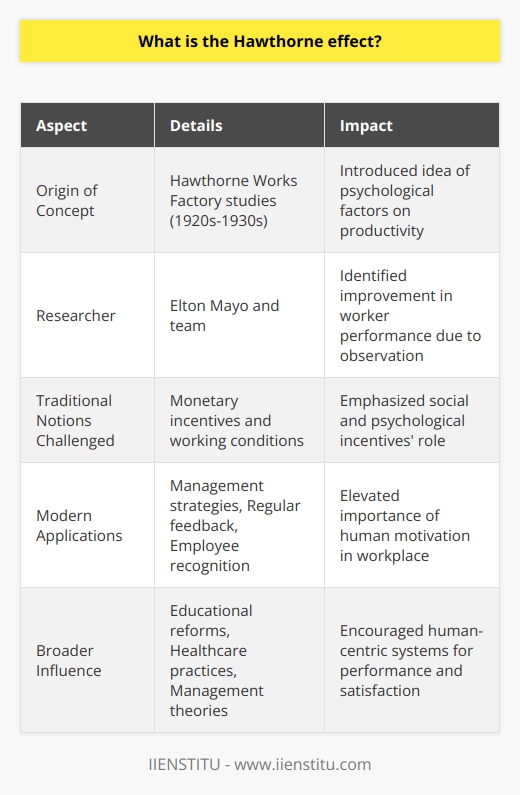
What is Maslow's hierarchy of needs?
Management theories have been around for centuries, and they provide valuable insight into the way different motivations can push or pull us through life. Maslow's hierarchy of needs is one of the oldest management theories known today; it was introduced in 1943 and since then has become a renowned structure used to explain human motivations and social behavior. According to Maslow, human needs are organized in a hierarchical order, with 'basic' needs at the bottom of the pyramid and more 'comfortable' needs at the top. At the base level are physiological needs such as food and sleep, followed by safety and security, love/belonging, esteem (self-respect), and finally self-actualization (realizing personal potential). As an individual progresses through his or her life in these stages, it provides a picture of how our desires might change over time, affecting our decision making processes along the way. This theory is an important first step in understanding how to best manage and lead people in any situation. Maslow's hierarchy of needs provides us with insight on why we feel what we feel and ultimately guides us towards achieving overall well-being both at home and at work.

How does the theory of bureaucracy help improve organizational efficiency?
The theory of bureaucracy helps improve organizational efficiency by providing a structure and set of rules for the organization to follow. This structure helps to ensure that tasks are completed in an efficient manner, as all members of the organization know their roles and responsibilities and how they should be performed. It also helps to reduce the amount of time spent on organizational tasks, as tasks can be delegated and completed more quickly and efficiently. Additionally, it helps to maintain order and continuity, and enables the organization to respond quickly and effectively to changes in the environment.
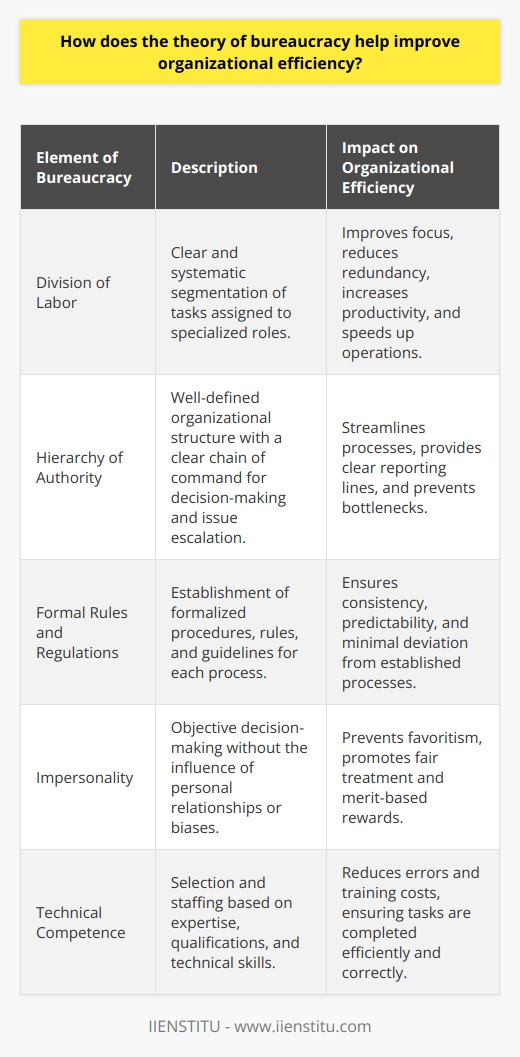
How can the theory of organizational culture help create a positive work environment?
The theory of organizational culture can help create a positive work environment by emphasizing the importance of shared values, beliefs, and behaviors among the members of the organization. This can be done by encouraging open communication, setting clear goals and expectations, and fostering a sense of community and collaboration. Additionally, it can help to foster an environment of mutual respect, trust, and support. These elements will create an environment where employees feel valued and appreciated, and work together to achieve common goals.

How can the theory of total quality management help organizations reduce costs and improve customer satisfaction?
Total Quality Management (TQM) is a business management strategy that emphasizes continual improvement in all areas of the organization. It involves establishing processes and procedures that help ensure that quality standards are maintained and that customer needs are met. By focusing on continual improvement, organizations can reduce costs and improve customer satisfaction by eliminating waste, increasing productivity, and improving customer service. TQM also encourages customer feedback and encourages employees to take ownership of their work and take responsibility for their own performance. With these measures in place, organizations can ensure that their processes are efficient and effective, leading to cost savings and improved customer satisfaction.
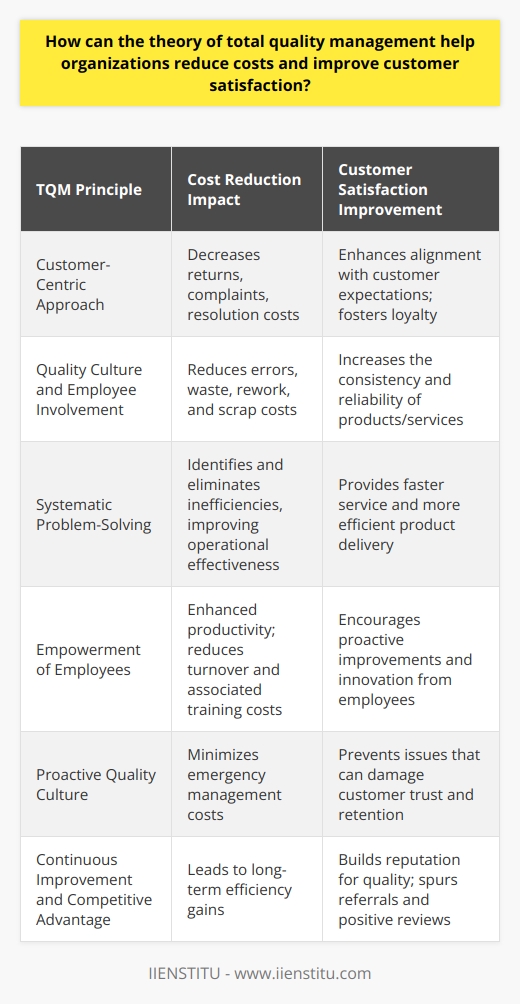
What are the key principles of systems theory in management?
Key Principles of Systems Theory in Management
Understanding the Components
One fundamental principle of systems theory in management is the notion that organizations can be understood as a system of interconnected components. These components work together to achieve a specific purpose, with each part having a specific function and impact on the whole system.
Interdependency and Interaction
Another key principle of systems theory in management is the emphasis on interdependency and interaction among the different elements within the system. System components do not operate in isolation but rather, they work together to create a complex and dynamic organizational environment. This principle recognizes the importance of effective communication and collaboration between departments, teams, and individuals within an organization.
Goal Orientation
Systems theory in management also emphasizes the importance of goal orientation, which means that all components and processes within an organization are aimed at achieving specific objectives. These objectives guide the actions and decisions of all organizational members, aligning their efforts towards a common purpose and ensuring that the organization operates in a coherent and purposeful manner.
Adaptability and Change
A key characteristic of systems theory in management is adaptability, acknowledging that organizations must be flexible and responsive to external forces, such as market trends, customer demands, and technological advancements. This principle emphasizes the need for organizations to adapt and evolve in response to changing circumstances, ensuring long-term survival and success.
Feedback and Continuous Improvement
Finally, systems theory in management highlights the significance of feedback and continuous improvement. This principle encourages organizations to routinely assess and evaluate their performance, identifying areas of weakness or inefficiency and implementing measures to enhance overall effectiveness. Feedback loops within the organization, both formal and informal, are crucial for promoting a culture of ongoing growth and development.
In conclusion, the key principles of systems theory in management include understanding the components of the organization, recognizing the interdependency and interaction among these components, emphasizing goal orientation, promoting adaptability and change, and fostering feedback and continuous improvement. These principles provide a valuable framework for understanding and managing complex organizational environments, ultimately leading to more successful and efficient management practices.
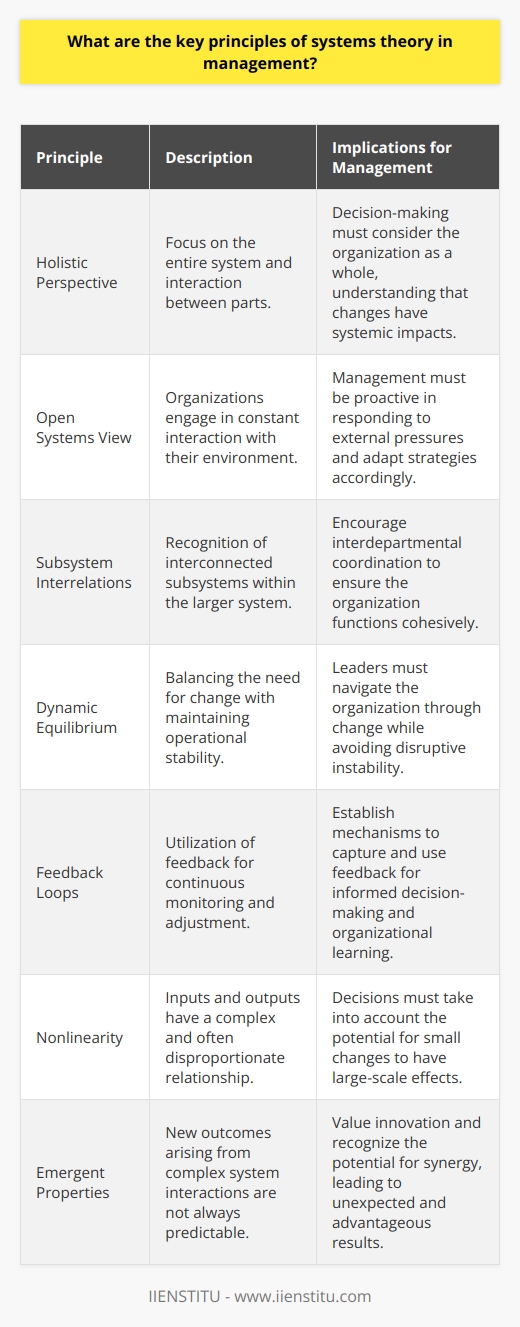
How does contingency theory influence decision-making and leadership styles in organizations?
Contingency Theory in Decision-Making
Contingency theory plays a significant role in shaping decision-making and leadership styles within organizations. This theory posits that effective leadership relies on the situational appropriateness of the leader's behavior or style to meet the demands of the environment. In other words, there is no one-size-fits-all or universal approach to leadership and decision-making – instead, adaptation is key.
Adapting Leadership Styles
Among the major elements of contingency theory are the need for leaders to assess their environment, determine the variables influencing the situation, and adjust their leadership behaviors accordingly. Consequently, a leader can exhibit various styles depending on the situation at hand. They might choose to be more autocratic or directive in times of crisis while embracing a democratic or participative style when engaging in long-term strategizing.
Matching Style with Situation
The contingency theory emphasizes that leaders must recognize the situational demands and adjust their decision-making processes accordingly. This alignment involves understanding the tasks, the nature of the workforce, and the preferences of the employees. A clear grasp of such considerations allows leaders to design and implement strategies that are tailored to the specific context in which they operate.
Situational Variables and Organizational Performance
Another essential facet of the contingency theory is its emphasis on how leaders should consider situational variables, such as technology and organizational structure, when making decisions. The theory posits that organizational performance is maximized when leaders match their chosen style with the most effective mode of operation dictated by such contingencies. For instance, a centralized structure may exhibit a more top-down decision-making approach, while a decentralized structure may warrant a more collaborative and participative leadership style.
Embracing Flexibility and Adaptability
Lastly, contingency theory highlights the importance of leaders developing a versatile repertoire of skills and styles to adapt to various situations. Embracing flexibility and adaptability enables leaders to make informed decisions and take appropriate actions based on the specific circumstances they encounter. This ongoing situational assessment and response ultimately contribute to enhanced organizational effectiveness and success.
In conclusion, contingency theory heavily influences decision-making and leadership styles within organizations by emphasizing the importance of situational appropriateness, adaptation, and flexibility. Leaders who recognize and respond effectively to the situational demands of their environment are better equipped to steer their organizations towards success.
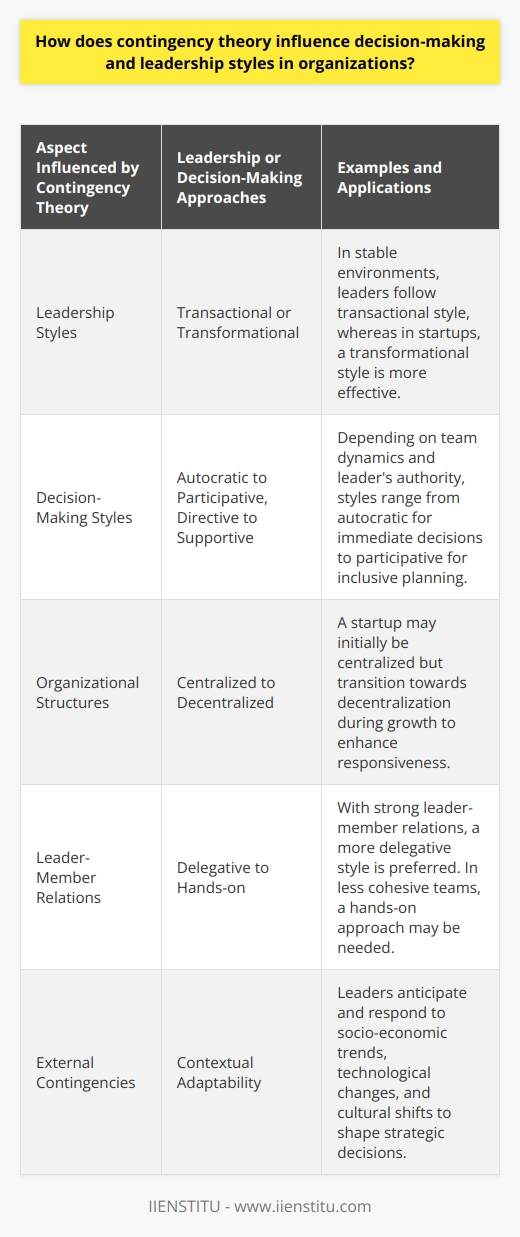
In what ways does the stakeholder theory impact corporate social responsibility and ethical decision-making?
Stakeholder Theory and Corporate Social Responsibility
The stakeholder theory, as proposed by R. Edward Freeman in his book, Strategic Management: A Stakeholder Approach (1984), assumes that a corporation's management must consider the interests of all stakeholders (such as customers, employees, suppliers, shareholders, and community members) when making decisions. This theory significantly impacts corporate social responsibility (CSR) and ethical decision-making in various ways.
Promoting Ethical Decision-Making
Firstly, by acknowledging the interests of diverse stakeholder groups, the stakeholder theory drives corporations to adopt a holistic approach to decision-making. This approach promotes ethical processes and practices by encouraging managers to consider the potential consequences of their decisions on these stakeholders. Consequently, stakeholder theory promotes a strong ethical work culture and enhances corporate accountability.
Balancing Profitability and Stakeholder Needs
Secondly, the stakeholder theory challenges the traditional notion that a corporation's primary responsibility is exclusively towards shareholders. Instead, it fosters a balance between profitability and stakeholder needs, which in turn can improve corporate reputation and business performance. By prioritizing and addressing social and environmental concerns, corporations embrace their CSR obligations and contribute toward sustainable business growth.
Encouraging Stakeholder Engagement
Thirdly, the stakeholder theory underscores the importance of dialogue and engagement with various stakeholder groups. This open communication facilitates the identification of common concerns, as well as collaborative problem-solving and decision-making processes. In turn, this mutual understanding helps corporations develop CSR initiatives that cater to stakeholder needs and align with organizational goals.
Supporting Sustainability Initiatives
Finally, the stakeholder theory implicitly recognizes the crucial link between CSR and sustainability. By advocating for the consideration of a broader range of stakeholders' interests, the stakeholder theory encourages businesses to function as responsible global citizens. This approach results in corporations implementing sustainable practices and minimizing their negative environmental and social impacts.
In conclusion, the stakeholder theory impacts CSR and ethical decision-making in multiple ways by fostering a more inclusive approach to business management, balancing profitability with stakeholder needs, enhancing stakeholder engagement, and supporting sustainability initiatives. Ultimately, the stakeholder theory serves as a valuable framework for corporations to navigate the complex and interconnected web of modern business challenges.
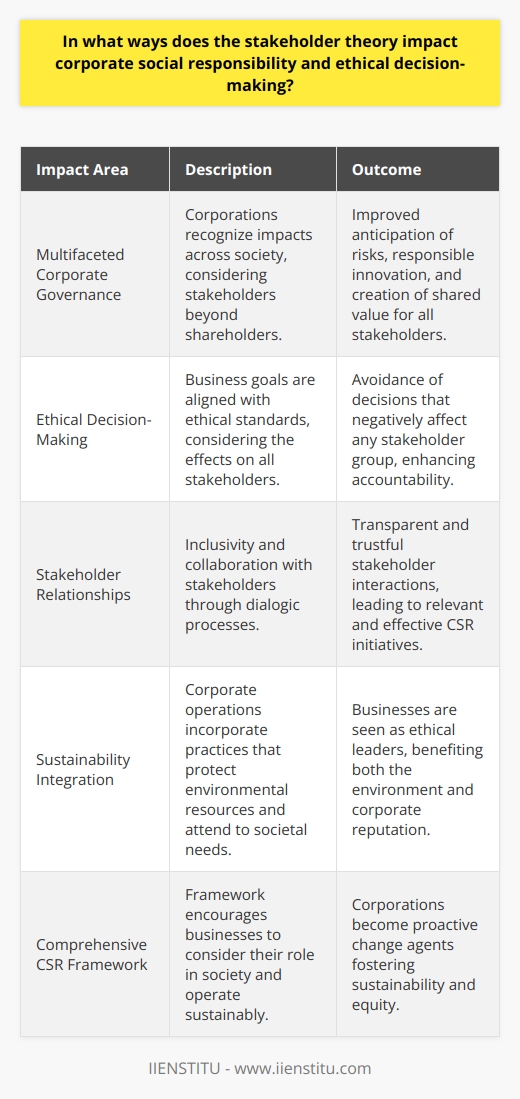
What are the core concepts of the seven theories of management, and how do they contribute to effective organizational performance?
Core Concepts of Management Theories
Scientific Management Theory
The scientific management theory, pioneered by Frederick Winslow Taylor, emphasizes the importance of task specialization, efficiency, and rule enforcement through studying and analyzing the most effective work practices. This approach contributes to organizational performance by promoting standardization, streamlining operations, and maximizing productivity.
Administrative Management Theory
Henri Fayol's administrative management theory posits that organizations should implement systematic management functions such as planning, organizing, commanding, coordinating, and controlling to ensure adequate structure and work distribution. A comprehensive framework fosters communication, decision-making, and resource allocation, driving organizational effectiveness.
Bureaucratic Management Theory
Max Weber's bureaucratic management theory advocates for hierarchical organization structures with formal rules, procedures, and impersonal relationships to ensure impartiality and authority. Implementing bureaucracy minimizes ambiguity, fosters consistent policies, and enhances managerial control, culminating in a stable and efficient organizational performance.
Human Relations Theory
Elton Mayo's human relations theory emphasizes the importance of social and psychological factors in fostering employee motivation, satisfaction, and overall well-being. By creating a positive work environment, addressing employee needs, and promoting cooperation, organizations can witness increased productivity, employee retention, and workforce morale.
Systems Theory
The systems theory, often associated with Ludwig von Bertalanffy, adopts a holistic approach to management, viewing organizations as open, complex systems with interdependent parts. Recognizing relationships and interactions between various organizational facets encourages adaptability, agility, and optimal problem-solving, boosting overall performance.
Contingency Theory
The contingency theory posits that there is no one-size-fits-all approach to management, as optimal leadership practices are contingent on various situational factors, including the organization's internal and external environments. This adaptive, context-based approach allows organizations to respond effectively to changing circumstances, maintaining peak performance.
Total Quality Management
Total quality management (TQM) focuses on continuous improvement and strategic integration of quality principles throughout the organization. By embracing customer-centric approaches, employee empowerment, and data-driven decision-making, TQM drives innovation, excellence, and heightened organizational performance.
In conclusion, the core concepts of the seven management theories encompass diverse yet complementary perspectives, emphasizing aspects such as efficiency, structure, employee well-being, adaptability, and quality improvement. By incorporating these principles, organizations can optimize their performance, ensuring sustained success and growth.
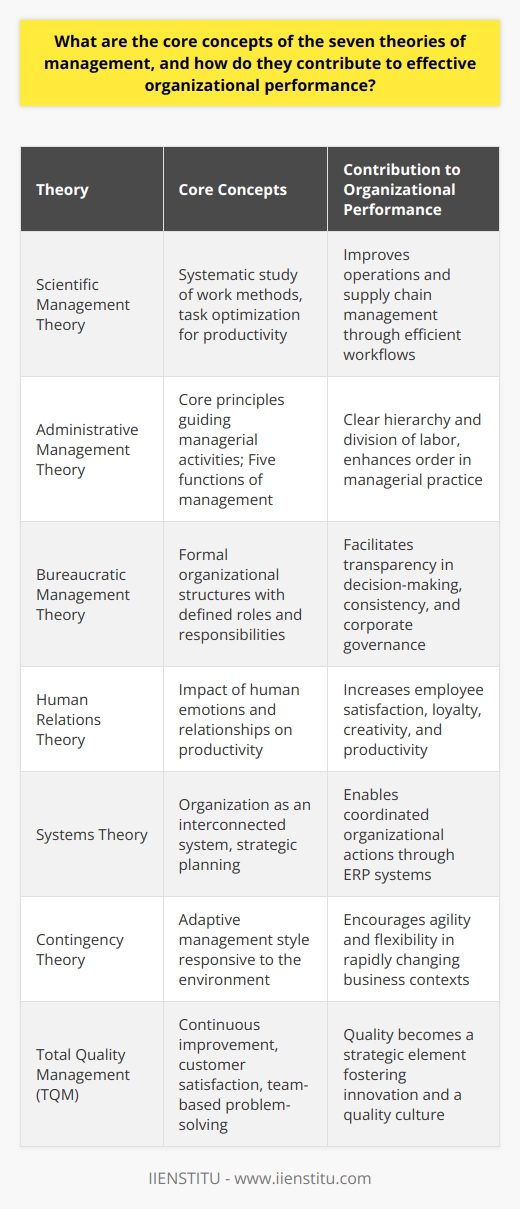
How have the main management theories evolved over time, and what factors have influenced these changes?
Early Management Theories
The inception of management theories can be traced back to the classical era, where prominent thinkers such as Frederick Taylor, Henri Fayol, and Max Weber sought to optimize organizational efficiency through scientific, administrative, and bureaucratic approaches. These theories were largely influenced by the industrial revolution, which prompted the need for systematic managerial tools that ensured maximum productivity.
Human Relations and Behavioral Approach
A shift in focus from classical theories to the human relations and behavioral approach emerged in the 1930s, primarily due to the Hawthorne Studies conducted by Elton Mayo. These studies highlighted the impact of employee behavior, motivation, and morale on productivity. Consequently, management theories began to emphasize group dynamics, effective communication, and leadership styles that fostered employee engagement and satisfaction.
Systems Theory and Contingency Approach
Subsequently, in the mid-20th century, management theories experienced a shift towards systems thinking, as proposed by Ludwig von Bertalanffy. This approach emphasized the interconnectedness of components within an organization, allowing for a more holistic understanding of organizational performance. In parallel, contingency theories emerged, positing that management actions should be tailored to suit specific situations and contexts. Business globalization and increasing environmental complexity led to an appreciation of these adaptable and integrative theories.
Total Quality Management and Beyond
In the 1980s, the advent of total quality management (TQM) saw a renewed focus on continuous improvement, customer satisfaction, and quality as the driving forces behind organizational success. Demands for greater efficiency and competitiveness in global markets spurred the adoption of TQM and similar methodologies.
Contemporary Management Thought
Modern management theories have continued to evolve, driven by technological advancements, workforce diversification, and changing societal values. Current thinking emphasizes agility, innovation, and sustainability, as organizations seek competitive advantage in an ever-changing landscape. Influential theories include learning organizations, lean management, and corporate social responsibility, all of which reflect the increasingly dynamic nature of today's business environment.
In conclusion, the evolution of management theories has been significantly influenced by historical and socio-economic factors. As organizations continue to face novel challenges and complexities, management theories will undoubtedly continue to progress and adapt to provide the most effective means of guiding organizational success.
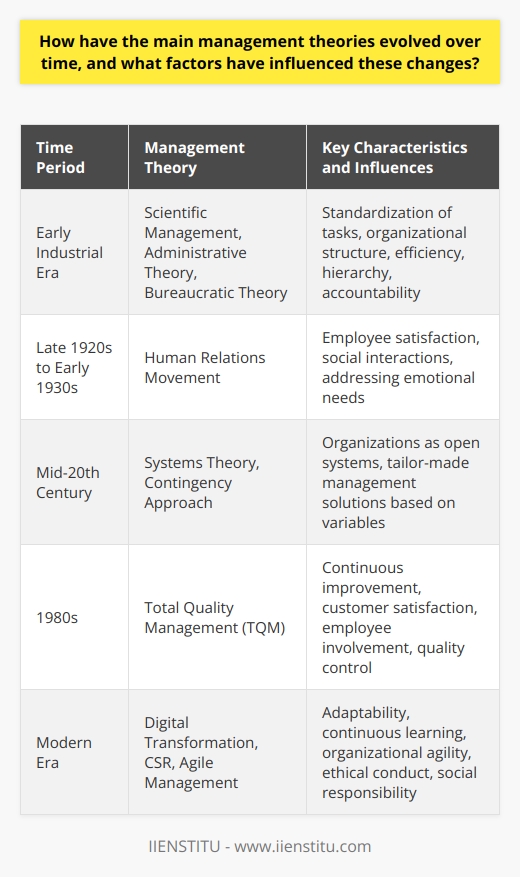
How can managers apply the 11 essential management theories to optimize their decision-making processes, enhance their communication and collaboration skills, and foster a more innovative work environment?
Applying Management Theories to Decision-Making Processes
Managers can optimize their decision-making processes by incorporating the Rational Decision-Making Model, which involves identifying problems, generating alternatives, evaluating options, and implementing the best choice. By leveraging the Bounded Rationality Theory, they can also acknowledge their cognitive limitations and use heuristics to simplify complex decisions. Additionally, managers can apply systems thinking to better understand interdependencies and recognize the long-term implications of their decisions.
Enhancing Communication and Collaboration Skills
By embracing the Contingency Theory, managers can adapt their communication style to suit different scenarios and employees. The Situational Leadership Model aids in identifying the most suitable leadership style based on team maturity, encouraging flexible communication. Employing the Social Exchange Theory, managers can create a mutual trust environment, fostering open communication with their reports. Moreover, the Johari Window Model can improve self-awareness, helping managers to identify potential communication blind spots.
Fostering a More Innovative Work Environment
Creating an innovative work environment requires the integration of various management theories. The Transformational Leadership Theory highlights the importance of inspiring and empowering employees, driving creativity and innovation. Managers can harness the effects of the Innovation Ambition Matrix to set forth strategic goals and prioritize innovative projects. By applying the ADKAR Model, they can ensure a smooth transition during change implementation, minimizing resistance and maintaining a positive work culture.
In conclusion, managers can enhance their decision-making processes, communication, and collaboration skills and foster a more innovative work environment by implementing the 11 essential management theories. Through continuous application and refinement of these theories, managers can achieve higher levels of effectiveness and success in today's dynamic business landscape.
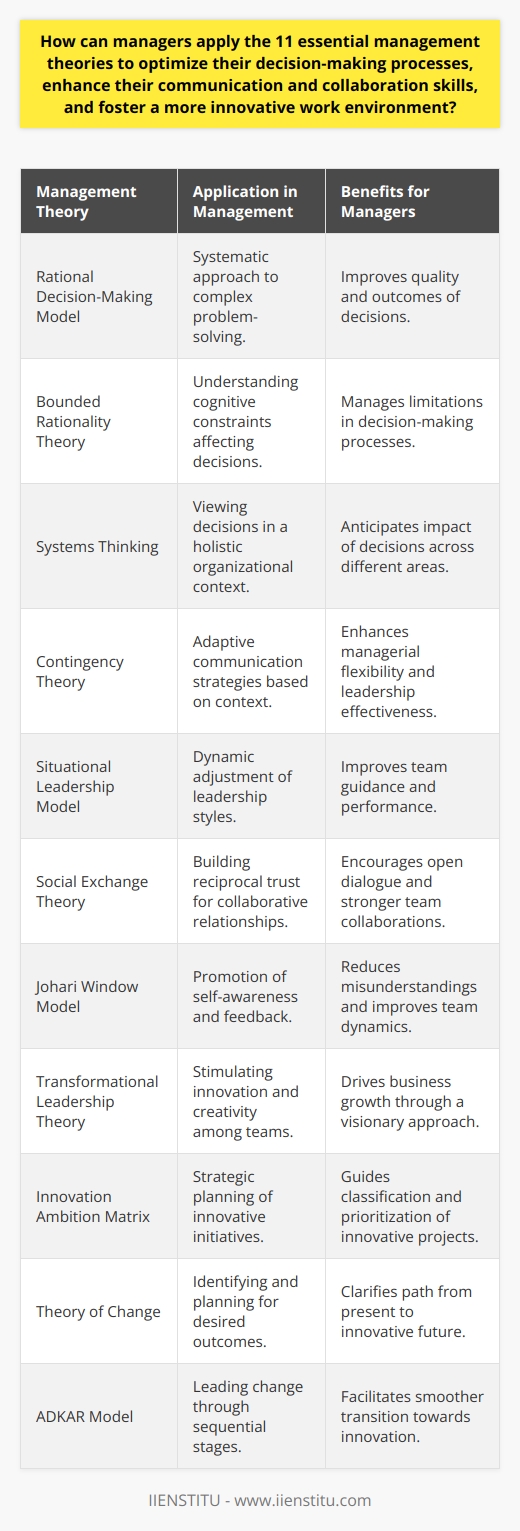
What are the key differences between the seven management theories, and how do these variations affect their application in different organizational contexts?
Classical Management Theory
The Classical Management Theory underlines efficiency, standardization, and process improvements. As such, it's best for production-based or manufacturing businesses that necessitate high efficiency and process control.
Neoclassical Theory
Contrastingly, the Neoclassical Theory prioritizes individual or group behavior and human relations. It works well in organizations that heavily value interpersonal relations, like service sector industries or NGOs.
Contingency Management Theory
With the Contingency Management Theory, decision-making differs based on the circumstance. This flexible approach works well in unpredictable, turbulent industries where managers must regularly adapt to new situations.
Systems Management Theory
The Systems Management Theory considers an organization as a complex system. It suits large, intricate organizations with many interconnected parts, like multinational enterprises or government bodies.
Chaos Theory
Chaos Theory deals with the unpredictability and lack of control that can occur in management. Innovative industries such as technology or design, which often deal with sudden unpredictable changes, benefit from this theory.
Quality Management Theory
The Quality Management Theory focuses on customer satisfaction and continuous improvement. Customer-centered industries, such as retail or hospitality, adopt this theory to provide consistent customer experiences.
Scientific Management Theory
Lastly, the Scientific Management Theory emphasizes efficiency through time and motion studies. It applies best to mass production environments where timescales are crucial, such as assembly lines in car manufacturing.
In conclusion, the application of different management theories largely depends on an organization's nature. Each theory brings unique strengths to different organizational contexts, fostering effectiveness and performance in diverse ways. By understanding these key differences, organizations can choose and apply the theory that best fits their context, thereby enhancing their management processes and outcomes.
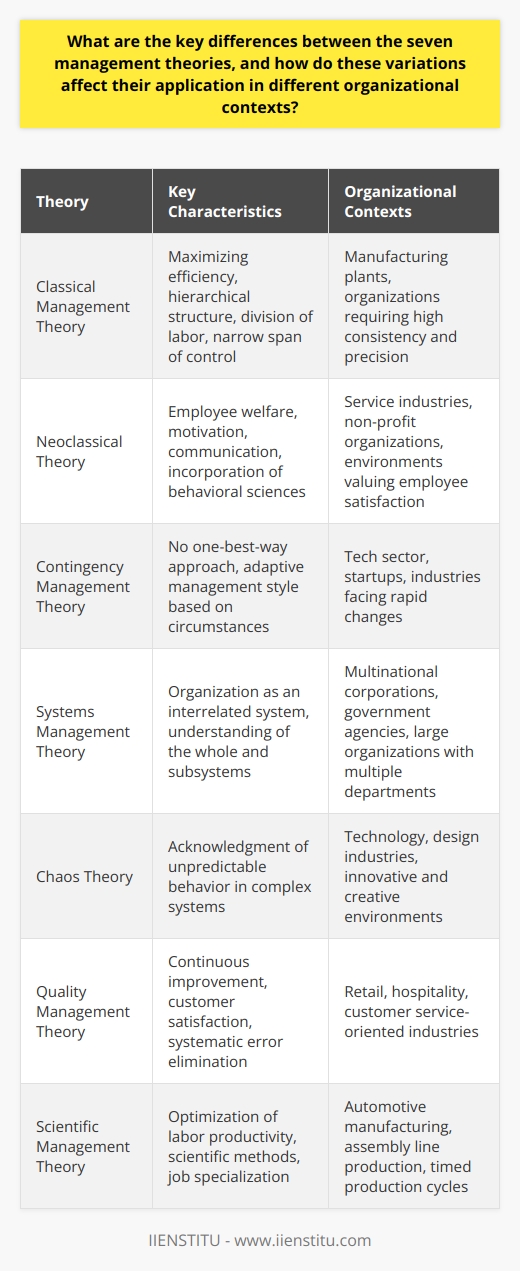
How have external factors, such as globalization and technological advancements, influenced the development and relevance of the 11 theories of management?
Influences of Globalization
Commencing with globalization, it considerably impacted the theories of management, fostering new approaches. Business operations expanded beyond national borders, hence necessitating international management theories. These theories focus on managing employees and resources scattered globally. Cross-cultural management, thereby, became crucial, inciting the need for theories to guide managers in managing cultural diversity. Additionally, globalization has increased competition, propelling the relevance of strategic management theories that provide a framework for competitive advantage.
Impacts of Technological Advancements
On another note, technological advancements have revolutionized management theories. The advent of technology caused a shift from the traditional bureaucratic theories, with their rigid hierarchies and standardized routines, towards systems theory and contingency theory. The systems theory acknowledges the organization as an open system interacting with its environment, while contingency theory accentuates the need for adaptable management styles depending on varying situations. The application of technology also led to the realization of virtual teams, making the relevance of the 11 management theories even more indispensable to effectively manage such setups.
Overall, globalization and technological advancements have necessitated the continuous development and modification of management theories. These external factors have inherently influenced their continuing relevance by creating new business realities requiring sophisticated, adaptable and inclusive management approaches. While the existing body of management theories provide foundational guidelines, it is inevitable that they continue evolving in response to these external influences, enabling organizations to navigate the ever-changing business landscape more effectively.
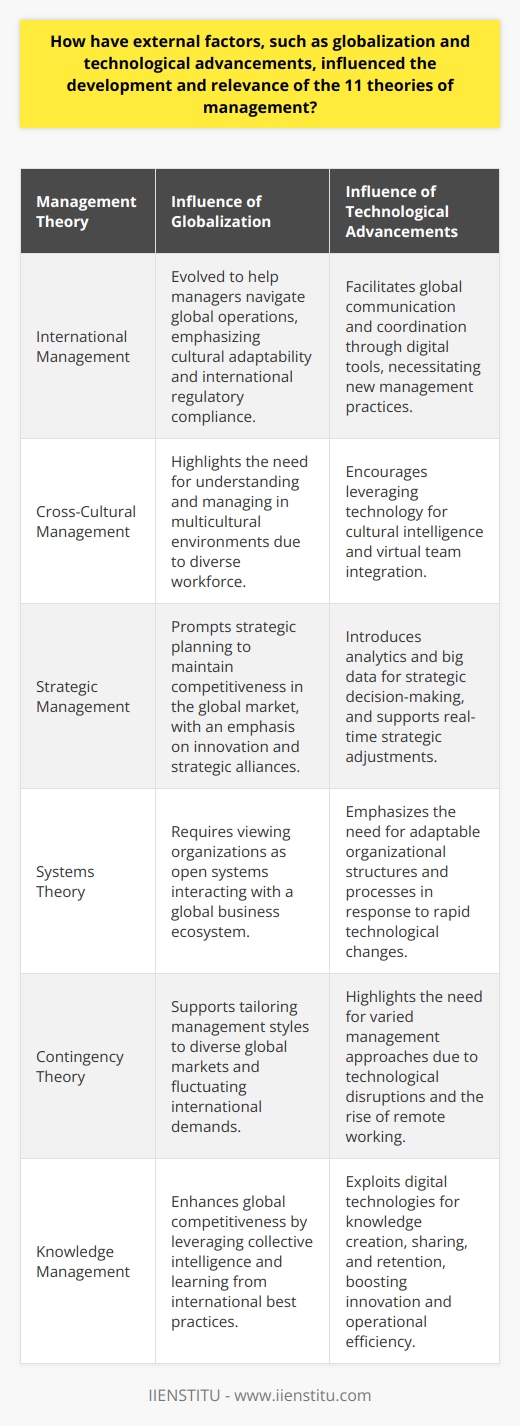
Which of the 4 major management theories have the most significant impact on the achievement of organizational goals, and why?
Theory of Significant Impact
Among the four major management theories, McGregor’s Theory X and Theory Y arguably have the most significant impact on achieving organizational goals. This theory has two contrasting perspectives on employee motivation, thus offering a broader understanding of employee behavior.
Central Significance of McGregor’s Theory
Theory X presumes that employees are inherently lazy and need strong guidance, while Theory Y believes employees are self-motivated and yearn for responsibility. This dichotomy enables managers to recognize the diversity in employee motivation, thereby adopting the most effective management style to enhance productivity.
Effect on Leadership
Leadership directly affects the accomplishment of organizational goals. Through the application of McGregor’s theory, managers can become more adaptive and responsive. They can cultivate a leadership style that increases workplace satisfaction, fostering a more effective workforce.
Employee Productivity Enhancement
The understanding and adaptation to the different motivation styles of employees can boost their productivity. This improved output can lead to the successful achievement of organizational goals.
Keeping Employees Motivated
By understanding that not all employees operate under the same motivational influences, managers can tailor their approach to keep the workforce engaged and motivated. This improved engagement can boost the entire organization's performance.
Influence on Organizational Environment
A positive, motivating, and encouraging workplace environment invariably leads to higher performance levels, productivity, and work satisfaction among employees. This positive impact on the organizational environment further promotes the achievement of organizational goals.
Thus, through its emphasis on the employee-manager relationship and, more importantly, its understanding of employee motivation, McGregor’s Theory X and Theory Y potentially have a significant effect on the achievement of organizational goals. The theory's adaptability and consideration of individual motivational factors make it an influential tool for managers across different industries.
